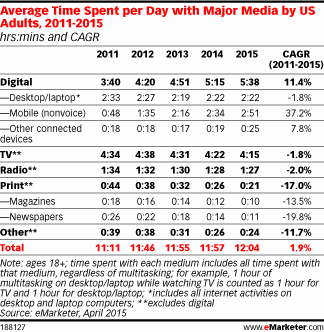Buyer Behavior Trends Driving The Digital Shift Toward Mobile
As consumer activity continues to move toward digital, marketers need to evolve to adapt to that trend. Columnist Soo Jin Oh shares stats to help you make the case in your company.

Buyer behavior is rapidly changing and forcing brands across all verticals to adjust and conform to the interactive world. Nearly every consumer activity has shifted to digital in some way — from listening to music, to shopping, to booking restaurant reservations, and so on.
Mary Meeker, a partner at venture capital firm Kleiner Perkins Caufield & Byers, recently pointed out in her annual “State of the Internet” address that mobile Internet usage is growing faster than Internet usage in general, up 23 percent compared with just 8 percent. In addition, the mobile ad industry as a whole grew 34 percent year over year, while desktop digital advertising only grew 11 percent.
These statistics prove that there is a clear shift in the way digital channels are being utilized, which means that brands must adapt and evolve their way of reaching consumers. We’re living in a consumer-driven market, and buyers’ trends will continue to shape the way that brands do business with their customers across channels and devices.
From Advertising To Improving The Customer Experience
These days, brands are recognizing the importance of delivering one-to-one communication to customers throughout the purchase cycle.
Customers are all looking for relevant communication that relates directly to their needs — no matter if they’re searching for a product or service, in the intent phase of considering whether to make a purchase, or have been consumers in the past and are looking to make a repeat buy.
Understanding how, why and when your customers engage with certain channels will lead to a better customer experience — and ultimately more sales.
Not only are customers turned off by inconsistencies across channels, but they’re also turned off when advertisements disrupt and aren’t integrated into their user experience.
Contextual relevancy is rising as an important facet for customers, according to a recent Forrester/Tapad report; 23 percent want ads to be tailored to the content they’re viewing, and 21 percent expect ads to be tailored to their location.
As marketers continue to marry first- and third-party data, they’ll be exposed to a larger data pool to deliver these customized experiences. In a report by MyBuys, three out of four shoppers said they’re willing to allow retailers to use in-store purchase data if that means the brand’s communication with them will be more personal.
From One Device To Multiple
The increasing number of media channels has created complications for marketers to determine when, and where, their customer is located along the purchase journey. While this fragmentation presents challenges, it also creates a huge opportunity, because there are now more interaction touchpoints.
The Forrester/Tapad report said consumers own more connected devices than ever, with more than 70% of connected consumers indicating that they personally use three or more devices.
It’s not just the devices that are multiplying; it is also the time spent engaging with content across screens.
Time spent with digital media has leaped to 5 hours and 38 minutes a day, with 2 hours and 51 minutes of that time being spent on mobile, according to eMarketer. This is due to the fact that consumers take their devices with them and engage on and off throughout the day and night.

We see this form of engagement through so many different aspects — online video, retailer sites both on desktop and mobile devices, mobile apps, social environments (like Facebook), and so on.
From Browsing To Buying
Meeker’s report states that in 1998, ecommerce represented less than 1 percent of retail revenue. Fifteen years later, ecommerce has grown nearly 9 percent, and growth estimates from eMarketer show that B2C ecommerce sales worldwide will have reached $1.5 trillion in 2014, increasing nearly 20 percent over 2013.
Because of more personalized ads, the increase in devices used by consumers, and the ability to deliver a better user experience by tapping into data, customers are rapidly becoming more excited and comfortable with online buying.
Buying online has become efficient, and the more marketers can do to make the experience easier — from finding relevant information to the ease of actually making the purchase — the more the dollars will flow to digital purchases.
As John Burbank, president of Strategic Initiatives at Nielsen, noted in a company statement, the rapidly changing digital landscape has shaped the consumer mindset into “adventurous” and “exploratory” when it comes to online shopping, and the “seemingly limitless options available in a virtual environments are providing more opportunities for merchants and consumers.”
And with the rise of the mobile payment options and digital wallets, the Internet is not just a mecca for information, but a simple and easy point of purchase. As consumers continue to drive the digital shift forward, marketers must adapt to these changes.
Contributing authors are invited to create content for MarTech and are chosen for their expertise and contribution to the search community. Our contributors work under the oversight of the editorial staff and contributions are checked for quality and relevance to our readers. MarTech is owned by Semrush. Contributor was not asked to make any direct or indirect mentions of Semrush. The opinions they express are their own.
Related stories